Impact of Surface Roughness on the Impingement of Urea–Water Solution Droplets
Abstract
1. Introduction
1.1. Motivation
1.2. Impingement Characterization
1.3. Influence of Fluid and Droplet Size
1.4. Influence of Surface Roughness on Droplet Impingement
1.5. Principal Conclusions and Main Aim of the Work
2. Materials and Methods
2.1. Test Bench Setup
2.2. Measurement Matrix and Surface Properties
2.3. Image Postprocessing and Mass-Fraction-Based Regime Classification
3. Results and Discussion
3.1. Influence of Roughness
3.2. Intensity of Roughness Influence
3.3. Influence of Topography
4. Conclusions
- An increased probability of thermal-induced breakup at lower temperatures, due to increased liquid–wall contact area for rough surfaces.
- Enhancement of mechanical breakup towards lower temperatures, caused by surface edges shearing secondary droplets off the spreading lamella.
- Reduced rebound at high temperatures, as surface peaks disturb and penetrate the vapor cushion between liquid and solid.
Author Contributions
Funding
Data Availability Statement
Acknowledgments
Conflicts of Interest
Abbreviations
| CFD | Computational fluid dynamics |
| CHF | Critical heat flux |
| DCG | Droplet chain generator |
| fps | Frames per second |
| LFP | Leidenfrost point |
| MBU | Mechanical breakup |
| NOx | Nitric oxides |
| Re | Reynolds-number |
| SCR | Selective catalytic reduction |
| TBU | Thermal-induced breakup |
| UWS | Urea-water solution |
| We | Weber-number |
References
- Quissek, M.; Lauer, T.; García-Afonso, O.; Fowles, S. Identification of Film Breakup for a Liquid Urea-Water-Solution and Application to CFD. In SAE Technical Paper Series; SAE International: Warrendale, PA, USA, 2019. [Google Scholar] [CrossRef]
- Liang, G.; Mudawar, I. Review of drop impact on heated walls. Int. J. Heat Mass Transf. 2017, 106, 103–126. [Google Scholar] [CrossRef]
- Bai, C.; Gosman, A.D. Developtment of Methodology for Spray Impingement Simulation. SAE Trans. 1995, 104, 550–568. [Google Scholar]
- Kuhnke, D. Spray/Wall–Interaction Modelling by Dimensionless Data Analysis. Ph.D. Thesis, Technische Universität Darmstadt, Darmstadt, Germany, 2004. [Google Scholar]
- Tran, T.; Staat, H.J.J.; Prosperetti, A.; Sun, C.; Lohse, D. Drop impact on superheated surfaces. Phys. Rev. Lett. 2012, 108, 036101. [Google Scholar] [CrossRef] [PubMed]
- Mundo, C.; Sommerfeld, M.; Tropea, C. Droplet-wall collisions: Experimental studies of the deformation and breakup process. Int. J. Multiph. Flow 1995, 21, 151–173. [Google Scholar] [CrossRef]
- Wachters, L.; Westerling, N. The heat transfer from a hot wall to impinging water drops in the spheroidal state. Chem. Eng. Sci. 1966, 21, 1047–1056. [Google Scholar] [CrossRef]
- Quissek, M.; Budziankou, U.; Lauer, T. A Novel Approach for the Impingement of AdBlue-Droplets based on Smooth Regime Transitions. In SAE Technical Paper Series; SAE International: Warrendale, PA, USA, 2020. [Google Scholar] [CrossRef]
- Börnhorst, M.; Deutschmann, O. Single droplet impingement of urea water solution on a heated substrate. Int. Heat Fluid Flow 2018, 69, 55–61. [Google Scholar] [CrossRef]
- Moita, A.S.; Moreira, A. Drop impacts onto cold and heated rigid surfaces: Morphological comparisons, disintegration limits and secondary atomization. Int. J. Heat Fluid Flow 2007, 28, 735–752. [Google Scholar] [CrossRef]
- Kuhn, C.; Schweigert, D.; Kuntz, C.; Börnhorst, M. Single droplet impingement of urea water solution on heated porous surfaces. Int. J. Heat Mass Transf. 2021, 181, 121836. [Google Scholar] [CrossRef]
- Cossali, G.E.; Marengo, M.; Santini, M. Thermally induced secondary drop atomisation by single drop impact onto heated surfaces. Int. J. Heat Fluid Flow 2008, 29, 167–177. [Google Scholar] [CrossRef]
- Koizumi, Y.; Shōji, M.; Monde, M.; Takata, Y.; Nagai, N. Boiling: Research and Advances; Elsevier: Amsterdam, The Netherlands, 2017. [Google Scholar]
- Wruck, N. Transientes Sieden von Tropfen beim Wandaufprall; Berichte aus der Verfahrenstechnik, Shaker: Aachen, Germany, 1999. [Google Scholar]
- Rioboo, R.; Tropea, C.; Marengo, M. Outcomes from a Drop Impact on Solid Surfaces. At. Sprays 2001, 11, 12. [Google Scholar] [CrossRef]
- Moita, A.S.; Moreira, A.L.N. Development of empirical correlations to predict the secondary droplet size of impacting droplets onto heated surfaces. Exp. Fluids 2009, 47, 755–768. [Google Scholar] [CrossRef]
- Habchi, C. A Comprehensive Model for Liquid Film Boiling in Internal Combustion Engines. Oil Gas Sci. Technol.—Rev. IFP 2010, 65, 331–343. [Google Scholar] [CrossRef]
- Liang, G.; Shen, S.; Guo, Y.; Zhang, J. Boiling from liquid drops impact on a heated wall. Int. J. Heat Mass Transf. 2016, 100, 48–57. [Google Scholar] [CrossRef]
- Birkhold, F. Selektive katalytische Reduktion von Stickoxiden in Kraftfahrzeugen: Untersuchung der Einspritzung von Harnstoffwasserlösung; Berichte aus der Strömungstechnik, Shaker: Aachen, Germany, 2007. [Google Scholar]
- Biance, A.L.; Clanet, C.; Quéré, D. Leidenfrost drops. Phys. Fluid. 2003, 15, 1632. [Google Scholar] [CrossRef]
- Tran, T.; Staat, H.J.J.; Susarrey-Arce, A.; Foertsch, T.C.; van Houselt, A.; Gardeniers, H.J.G.E.; Prosperetti, A.; Lohse, D.; Sun, C. Droplet impact on superheated micro-structured surfaces. Soft Matter 2013, 9, 3272. [Google Scholar] [CrossRef]
- Chandra, S.; Aziz, S.D. Leidenfrost Evaporation of Liquid Nitrogen Droplets. J. Heat Transf. 1994, 116, 999–1006. [Google Scholar] [CrossRef]
- Bernardin, J.D.; Stebbins, C.J.; Mudawar, I. Effects of surface roughness an water droplet impact history and heat transfer regimes. Int. J. Heat Mass Transf. 1997, 40, 73–88. [Google Scholar] [CrossRef]
- Steinbach, S. Einfluss der Transportvorgänge auf die Effizienz von Harnstoffkatalysatoren in SCR-Abgasanlagen. Ph.D. Thesis, Technische Universität München, München, Germany, 2007. [Google Scholar]
- Kubiak, K.J.; Wilson, M.; Mathia, T.G.; Carval, P. Wettability versus roughness of engineering surfaces. Wear 2011, 271, 523–528. [Google Scholar] [CrossRef]
- Antonini, C.; Amirfazli, A.; Marengo, M. Drop impact and wettability: From hydrophilic to superhydrophobic surfaces. Phys. Fluid. 2012, 24, 102104. [Google Scholar] [CrossRef]
- Moon, J.H.; Cho, M.; Lee, S.H. Dynamic contact angle and liquid displacement of a droplet impinging on heated textured surfaces. Exp. Therm. Fluid Sci. 2019, 101, 128–135. [Google Scholar] [CrossRef]
- Clanet, C.; Béguin, C.; Richard, D.; Quéré, D. Maximal deformation of an impacting drop. J. Fluid Mech. 2004, 517, 199–208. [Google Scholar] [CrossRef]
- Schweigert, D.; Damson, B.; Lüders, H.; Stephan, P.; Deutschmann, O. The effect of wetting characteristics, thermophysical properties, and roughness on spray-wall heat transfer in selective catalytic reduction systems. Int. J. Heat Mass Transf. 2020, 152, 119554. [Google Scholar] [CrossRef]
- Akhtar, S.W.; Yule, A.J. Droplet Impaction on a Heated Surface at High Weber Numbers. In Proceedings of the ILASS-Europe 2001, Zurich, Switzerland, 2–6 September 2001. [Google Scholar]
- Castanet, G.; Caballina, O.; Lemoine, F. Drop spreading at the impact in the Leidenfrost boiling. Phys. Fluid. 2015, 27, 063302. [Google Scholar] [CrossRef]
- BASF. Technisches Merkblatt AdBlue. 2008. Available online: https://docplayer.org/70411218-Adblue-technisches-merkblatt.html (accessed on 10 May 2023).
- Karl, A.; Anders, K.; Rieber, M.; Frohn, A. Deformation of liquid droplets during collisions with hot walls: Experimental and Numerical Results. Part. Part. Syst. Charact. 1996, 13, 186–191. [Google Scholar] [CrossRef]

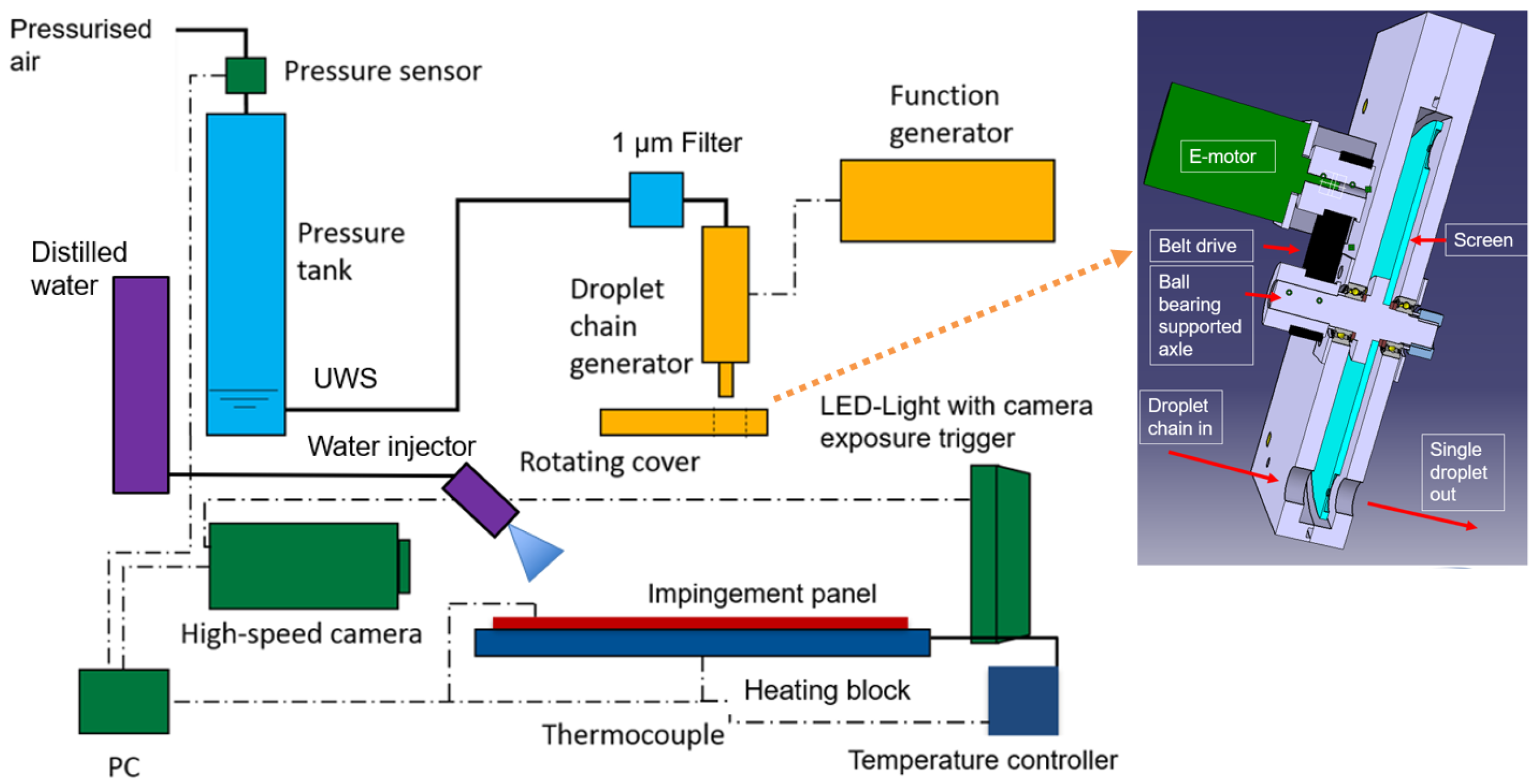


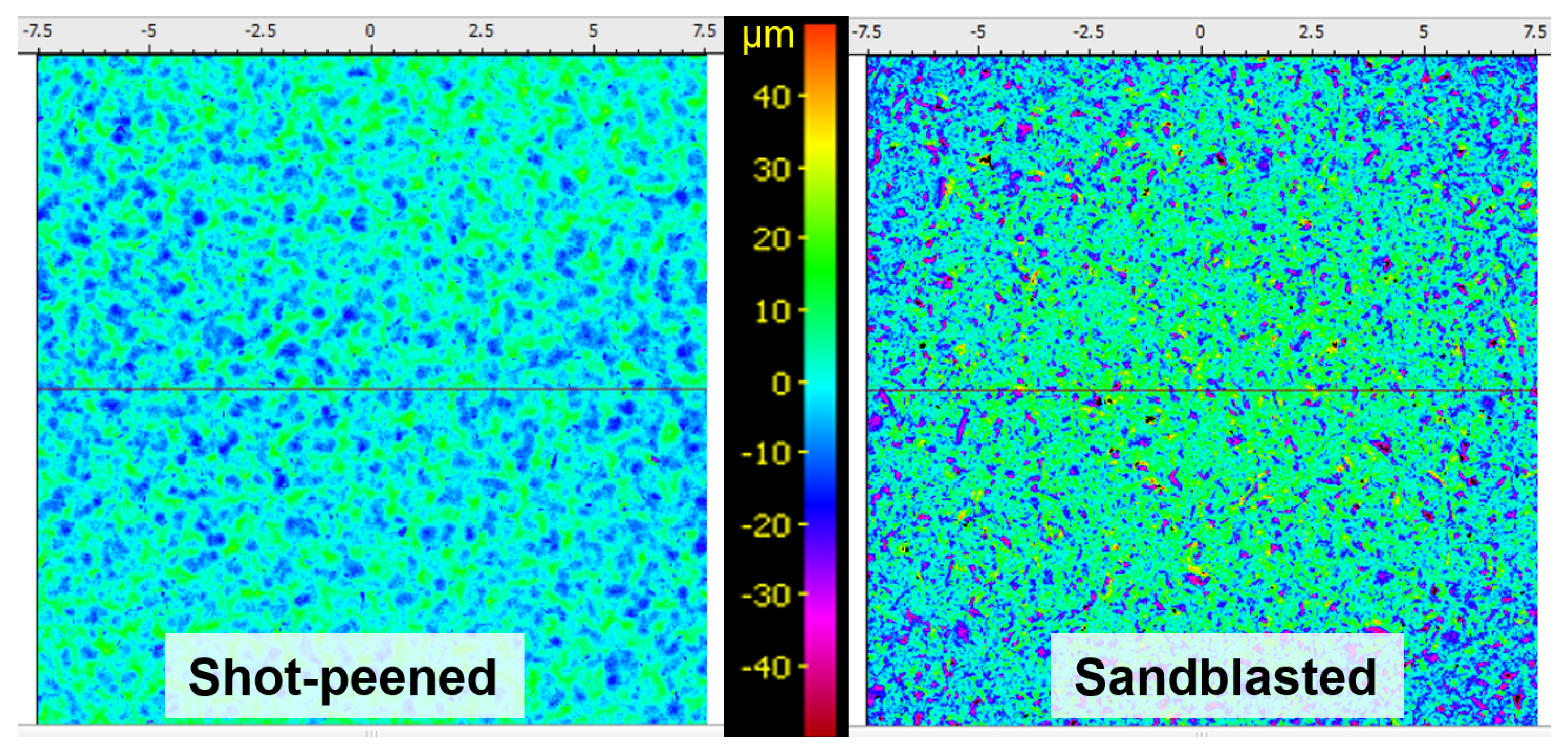
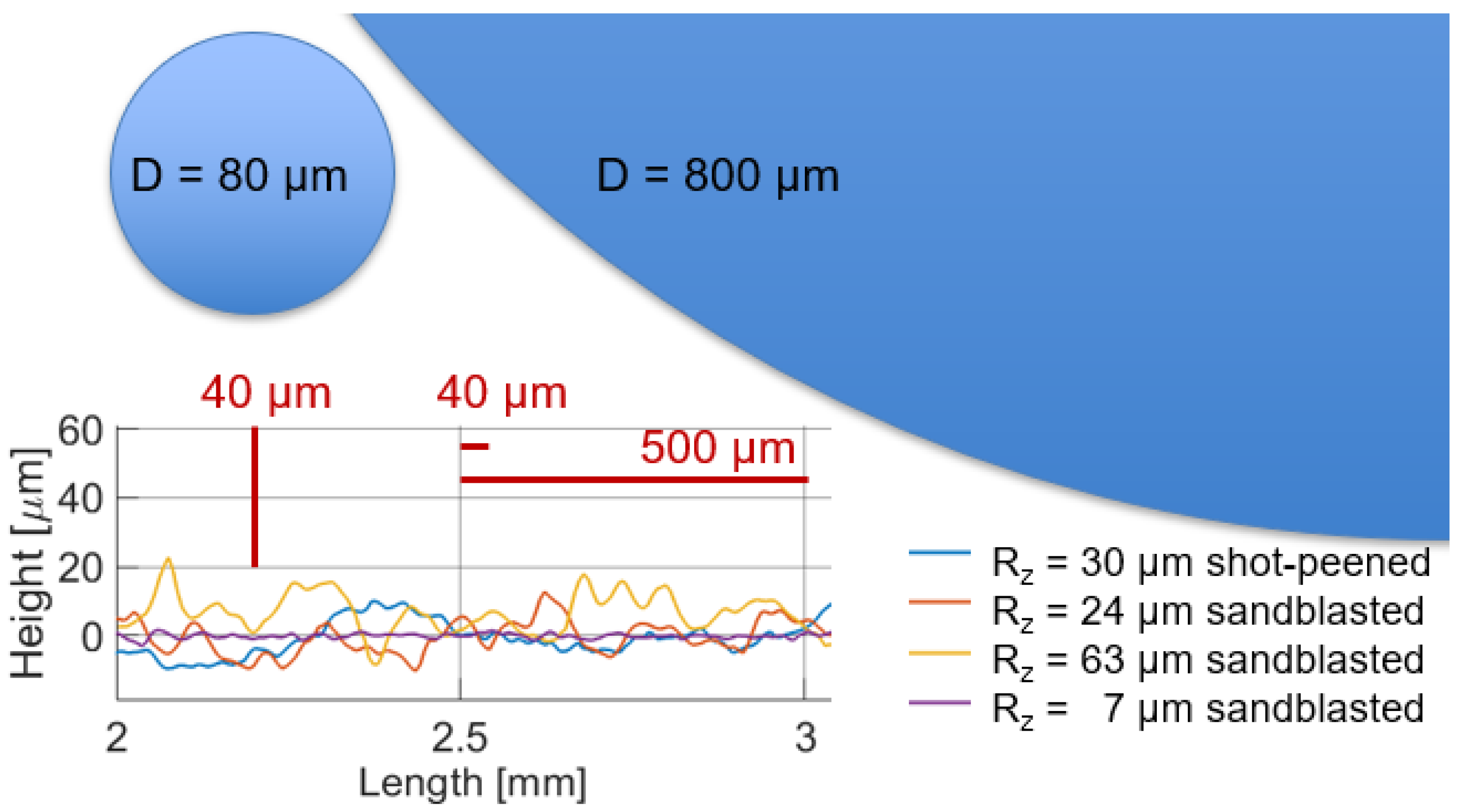
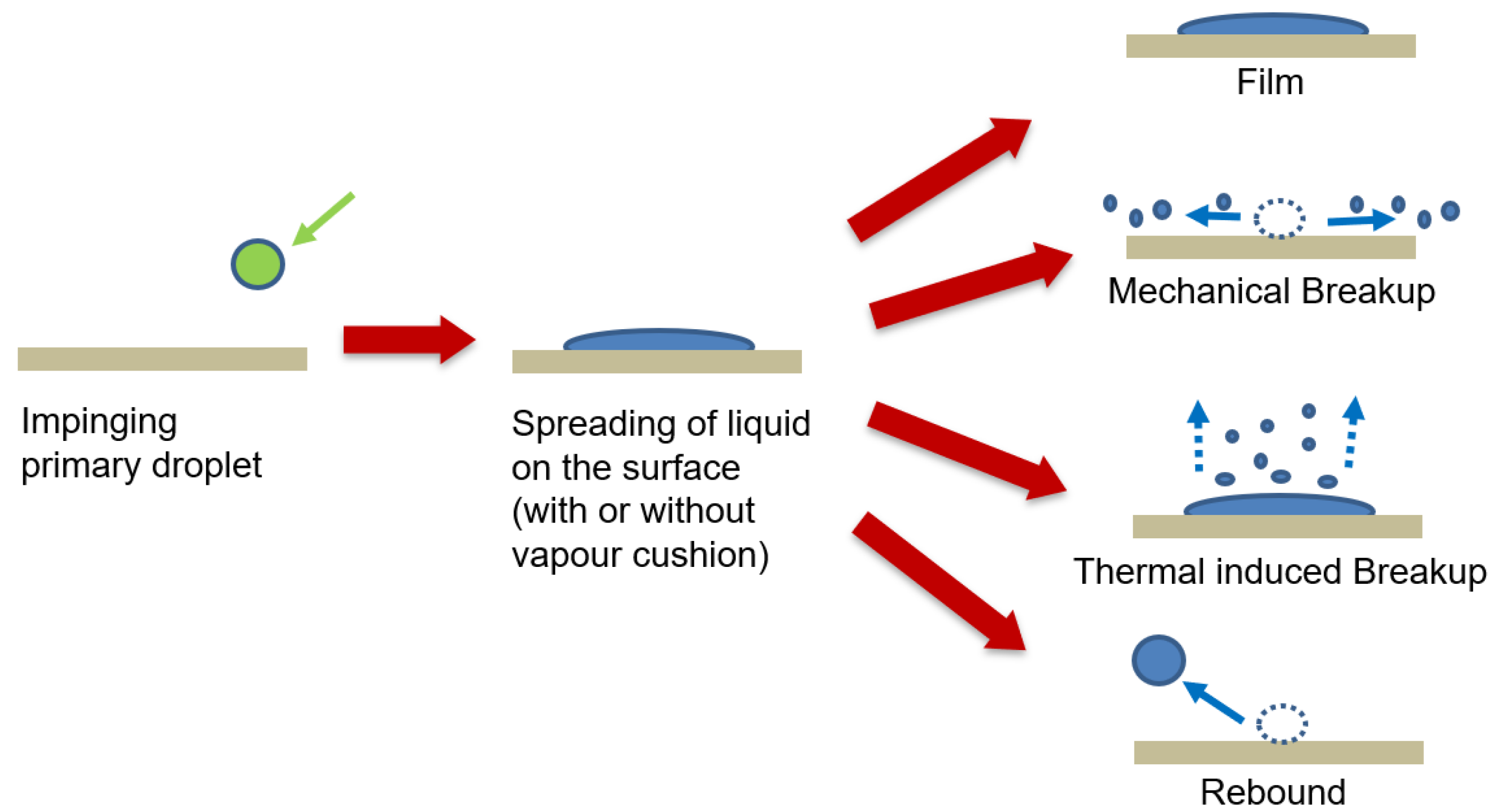

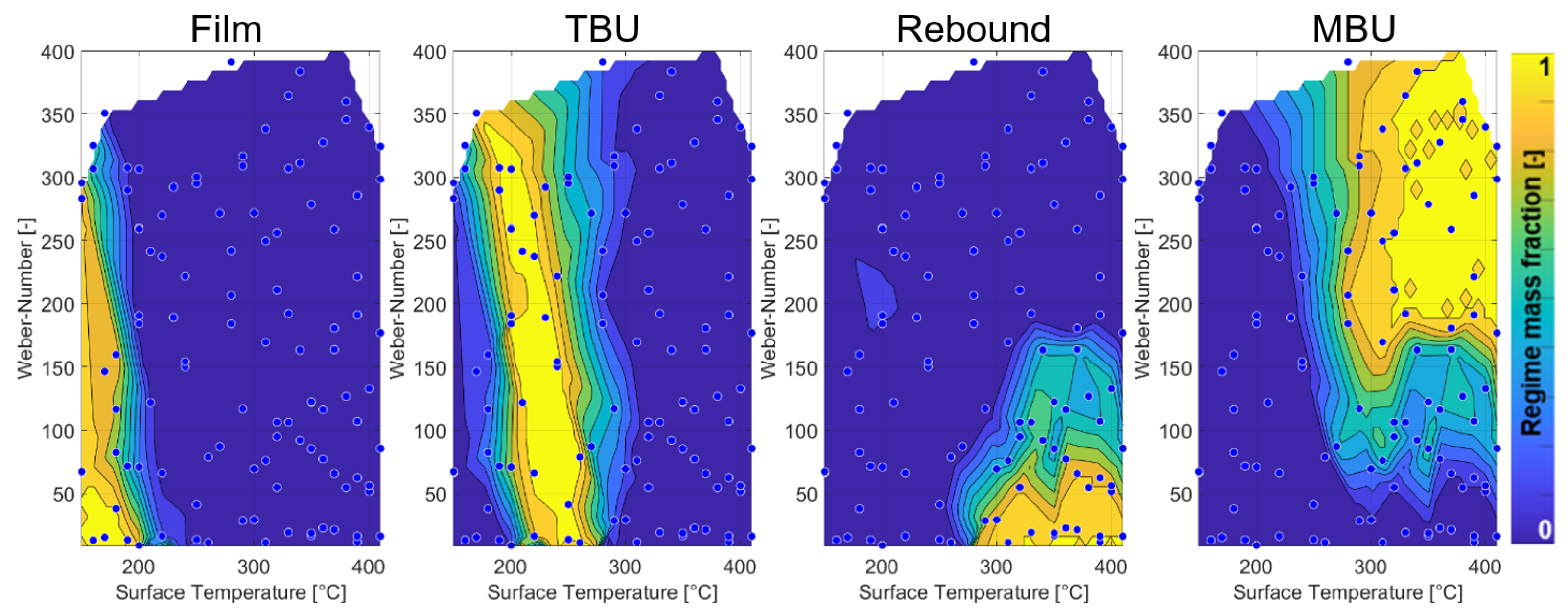
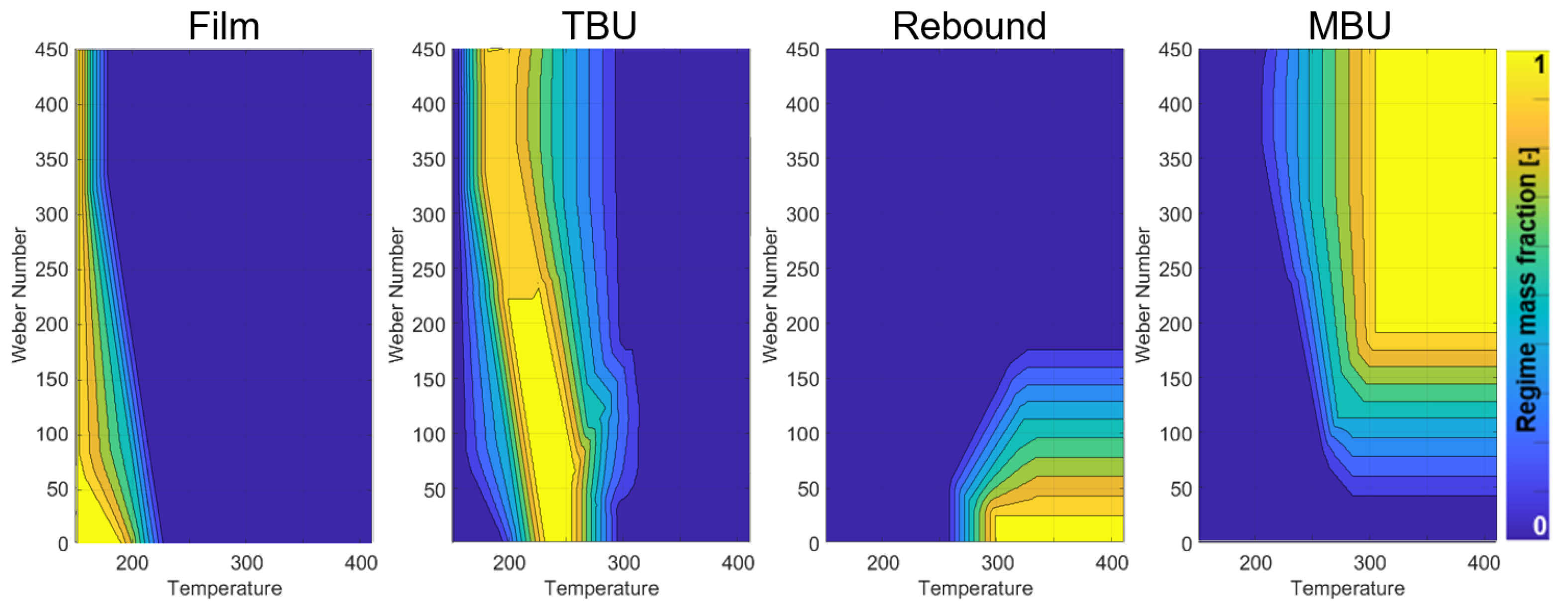
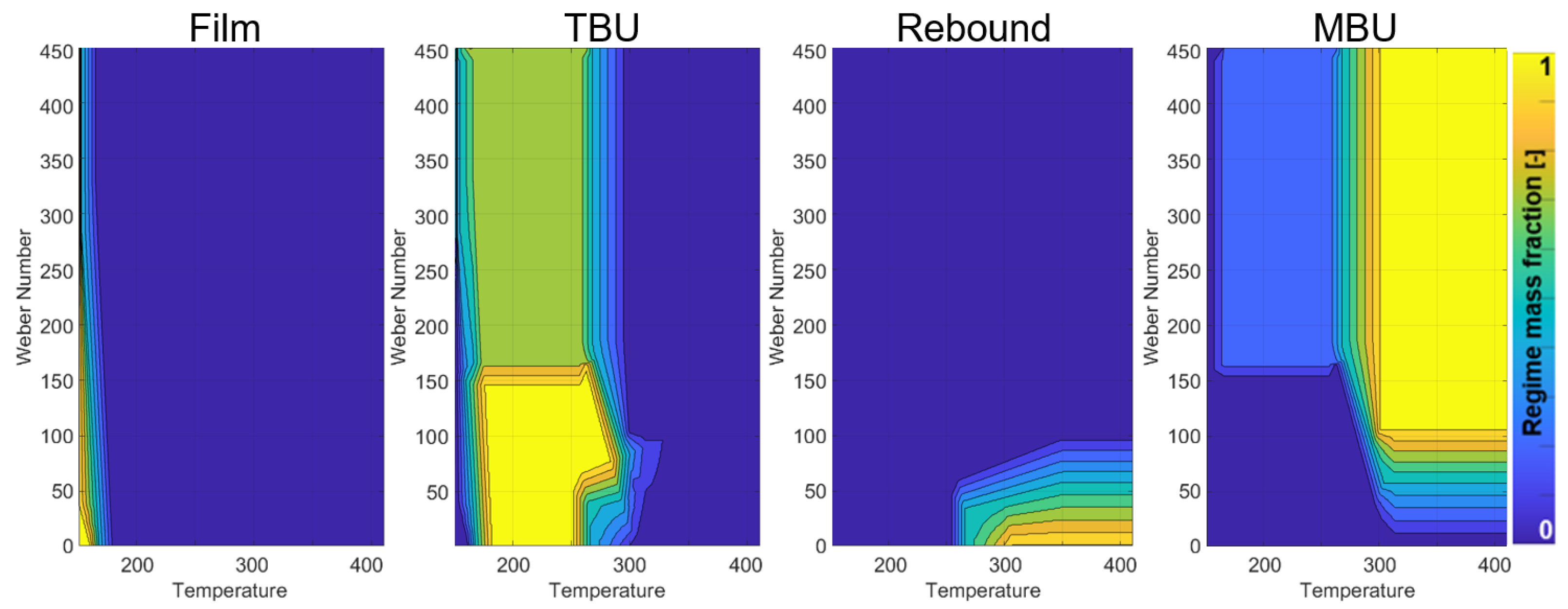

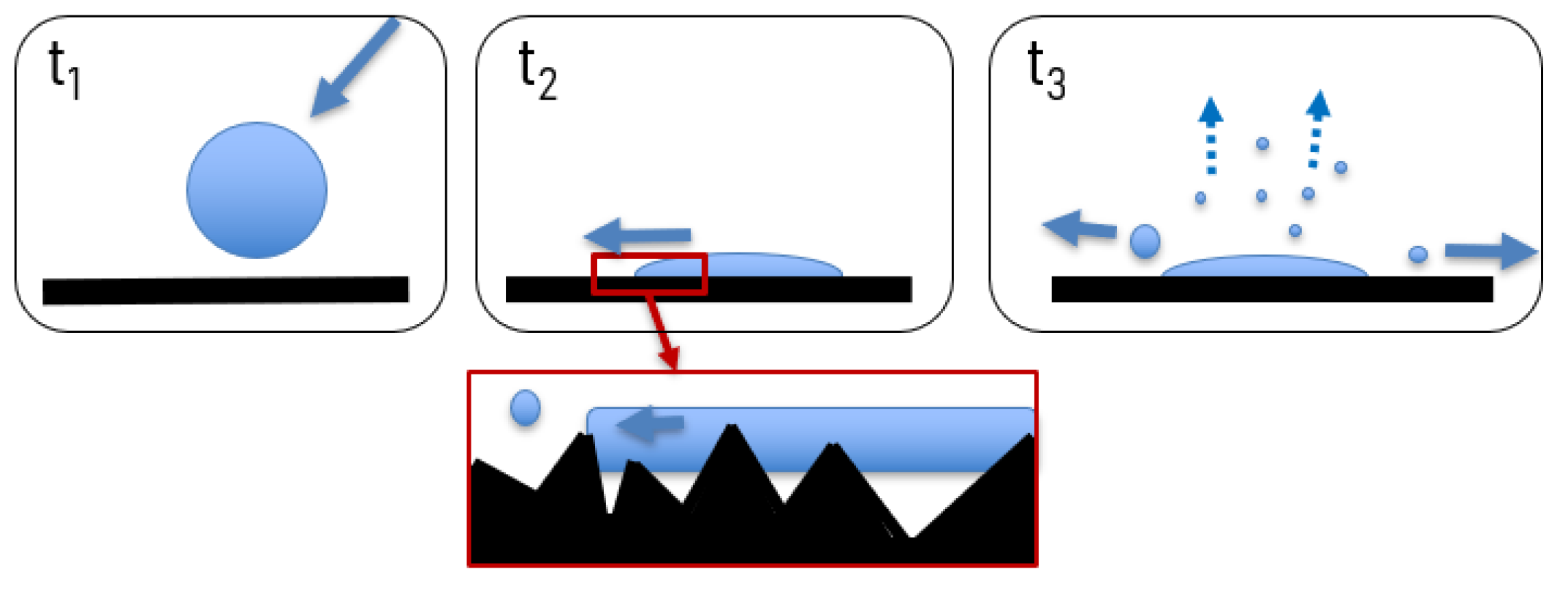

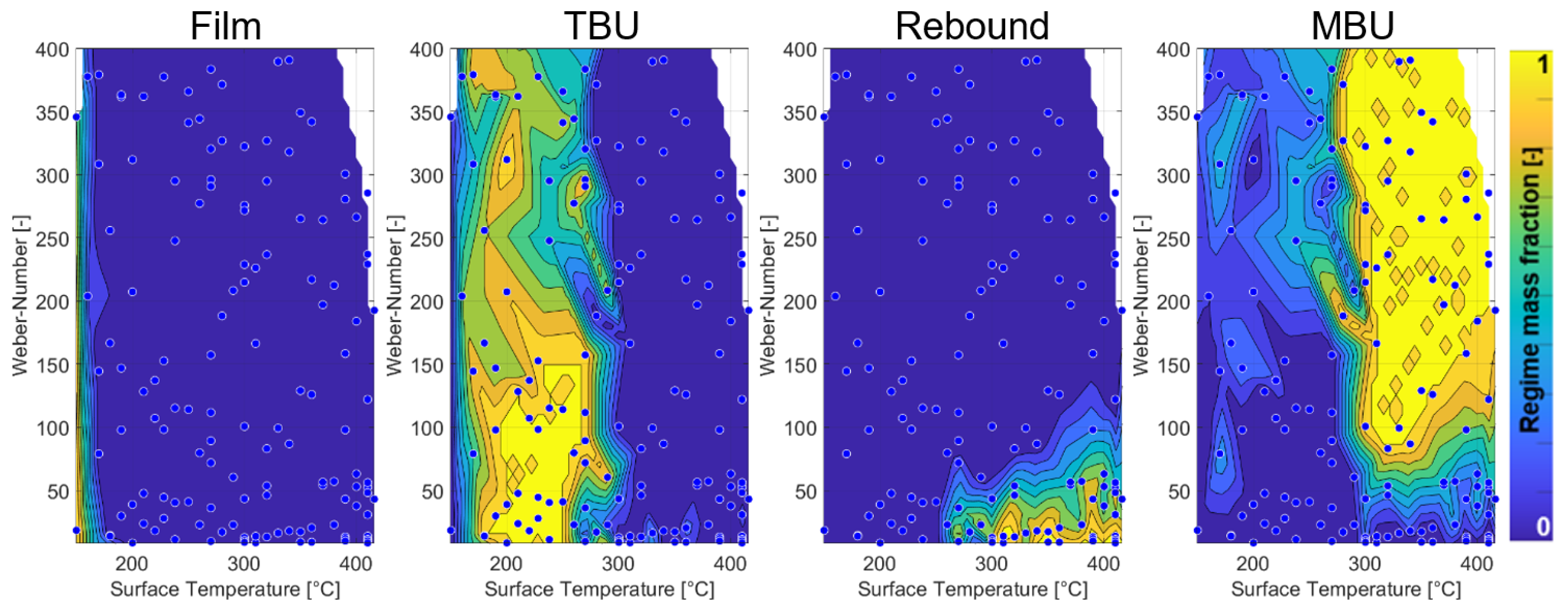

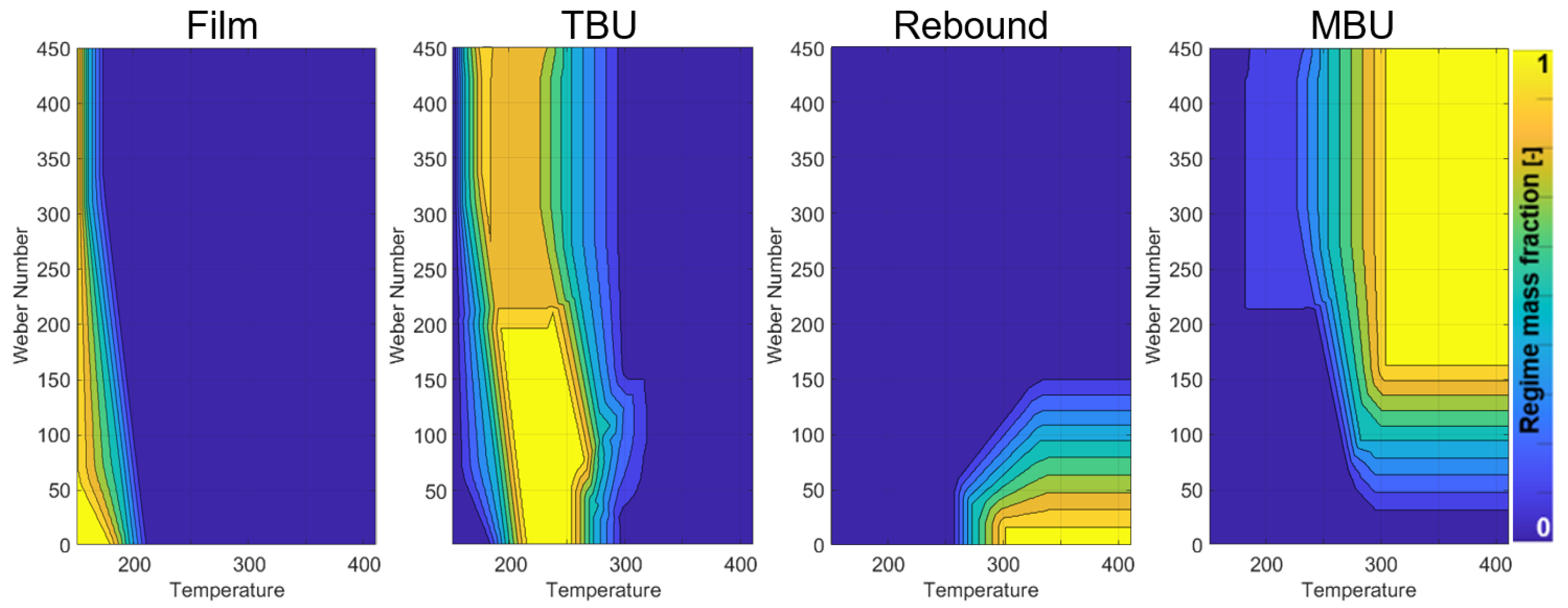
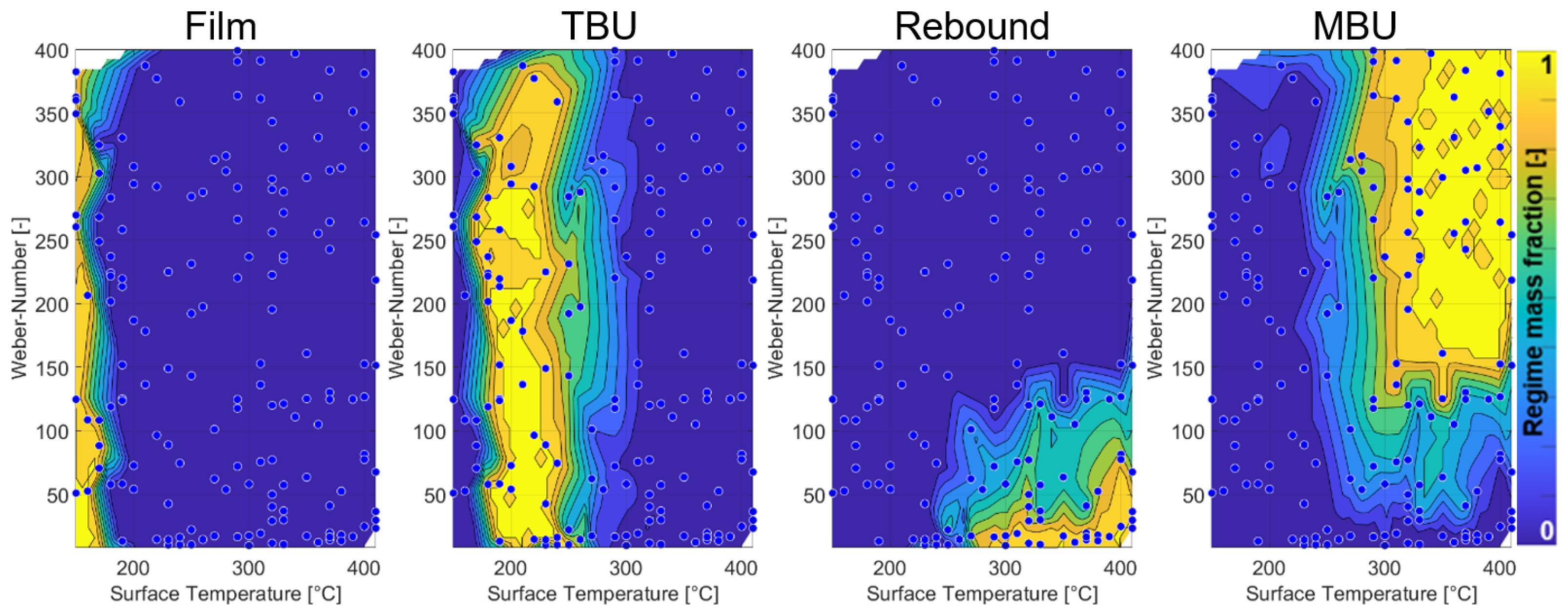
| Density | Dynamic Viscosity | Surface Tension | |
|---|---|---|---|
| UWS | 1087 |
| Panel ID | Ra | Rz | Sa | Sz | Surface Treatment |
|---|---|---|---|---|---|
| ID 001 | sandblasted | ||||
| ID 002 | sandblasted | ||||
| ID 005 | shot-peened | ||||
| ID 009 | untreated |
| Parameter | Unit | Range |
|---|---|---|
| Velocity | m/s | |
| Velocity wall-normal | m/s | |
| Droplet diameter | ||
| Weber-number | − | |
| Impingement angle | ||
| Surface temperature |
| Panel ID | 1 | 2 | 5 | 9 |
|---|---|---|---|---|
| Surface Treatment | sandblasted | sandblasted | shot-peened | untreated |
| Rz | 24 | 63 | 30 | 7 |
| Rdq |
Disclaimer/Publisher’s Note: The statements, opinions and data contained in all publications are solely those of the individual author(s) and contributor(s) and not of MDPI and/or the editor(s). MDPI and/or the editor(s) disclaim responsibility for any injury to people or property resulting from any ideas, methods, instructions or products referred to in the content. |
© 2023 by the authors. Licensee MDPI, Basel, Switzerland. This article is an open access article distributed under the terms and conditions of the Creative Commons Attribution (CC BY) license (https://creativecommons.org/licenses/by/4.0/).
Share and Cite
Quissek, M.; Lauer, T. Impact of Surface Roughness on the Impingement of Urea–Water Solution Droplets. Fluids 2023, 8, 152. https://doi.org/10.3390/fluids8050152
Quissek M, Lauer T. Impact of Surface Roughness on the Impingement of Urea–Water Solution Droplets. Fluids. 2023; 8(5):152. https://doi.org/10.3390/fluids8050152
Chicago/Turabian StyleQuissek, Max, and Thomas Lauer. 2023. "Impact of Surface Roughness on the Impingement of Urea–Water Solution Droplets" Fluids 8, no. 5: 152. https://doi.org/10.3390/fluids8050152
APA StyleQuissek, M., & Lauer, T. (2023). Impact of Surface Roughness on the Impingement of Urea–Water Solution Droplets. Fluids, 8(5), 152. https://doi.org/10.3390/fluids8050152







